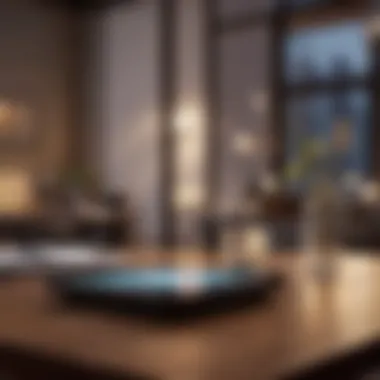Tabletop Lighting: Enhancing Modern Interiors


Intro
In the realm of contemporary design, tabletop lighting plays a pivotal role that often gets overlooked. It is not merely a source of light; it serves as a crucial element that can greatly influence the aesthetic and ambiance of a space. When one reflects on a well-designed room, the gentle glow emanating from a stylish lamp or an artistic lantern often captures the essence of the environment.
The dual functionality of these lighting fixtures—as practical illuminators and as design statements—makes them essential for modern interiors. Whether it’s a cozy reading nook or a vibrant dining area, the right tabletop light has the power to elevate the mood and contribute significantly to the overall feel.
As we navigate through current trends, styles, and innovations in tabletop lighting, it's important to take a close look at how these fixtures harmonize with various interior designs. This exploration will provide insights not just for homeowners but also designers and decor enthusiasts who seek to transform their living spaces into beautifully lit sanctuaries.
"Lighting is the canvas upon which a room is painted. Without it, the colors and textures remain hidden."
In this journey, we’ll dissect furniture styles and trends, delve into care and maintenance tips, and shine a spotlight on sustainable and smart technology in lighting solutions. Each aspect interconnects, shaping how tabletop lighting not only illuminates but also enhances everyday living experiences.
Let’s embark on this detailed exploration and illuminate our understanding of tabletop lighting in contemporary design.
Understanding Tabletop Lighting
Tabletop lighting can significantly elevate the aesthetic and functional aspects of a space. More than just a means to light up a room, these fixtures serve as focal points, complementing the overall theme of interior design. Homeowners and designers alike recognize that the intention behind selecting the perfect lamp goes beyond simply finding a source of light. It involves understanding how various lighting elements can alter moods, enhance creativity, and create a warm, inviting atmosphere.
Defining Tabletop Lighting
Tabletop lighting refers to various lighting fixtures that are designed to rest on flat surfaces like tables, desks, or shelves. This encompasses a wide range of styles, including table lamps, desk lamps, and even some forms of decorative lighting. The style can range from minimalist pendants to eclectic designs, creating versatility that fits into any decor theme.
Consider this: when a light fixture is placed on a table, it becomes an integral part of the space, contributing not only light but also personality. When you walk into a room and see a beautifully crafted lamp next to a stack of books, it creates a cozy vibe, drawing you in. Tabletop lights are often where function meets art.
Historical Context of Tabletop Lighting
The history of tabletop lighting is as rich as the designs themselves. Initially, simple candles provided the light needed in homes. These rudimentary forms of illumination were often placed on tables, leading to the earliest instances of what we now call tabletop lighting. As technology evolved, so did the fixtures. The introduction of oil lamps in the 19th century marked a transformative era, bringing with it designs that not only illuminated but also showcased craftsmanship.
With the advent of electric lighting in the early 20th century, tabletop fixtures evolved further, integrating new materials and forms into everyday life. The art deco movement, for instance, pushed boundaries by incorporating geometric shapes and lavish materials into lighting design, reflecting the era's artistic tendencies. Fast forward to today, and the variety is staggering— styles range from sleek industrial designs to ornate vintage reproductions. Each of these styles tells a story, echoing the needs and aesthetics of their time.
Design Styles of Tabletop Lights
When diving into the realm of tabletop lighting, it becomes abundantly clear that style is not just an aesthetic choice; it’s a reflection of personal taste and functionality. This section will explore how varied design styles bolster the purpose of lighting in contemporary interiors. Each style brings its own flair, shaping how light interacts with the spaces we inhabit. Moreover, understanding these designs aids homeowners and designers alike in creating cohesive looks that resonate harmony and balance throughout a room.
Contemporary Designs
Contemporary designs in tabletop lighting are characterized by sleek lines and innovative materials. These fixtures often blend functionality with artistic expression, serving as conversation starters in living rooms or studies. For instance, a lamp made from polished metal with geometric shapes not only offers light but also acts as a sculptural element. Designers today are increasingly experimenting with asymmetrical silhouettes and vibrant colors to keep the aesthetic fresh.
Consider how a contemporary lamp can infuse energy into a plain desk or side table—its structure and color options can seamlessly complement modern furniture styles. In practical terms, contemporary designs frequently incorporate energy-efficient LEDs, which provide bright illumination without the bulky look of traditional bulbs.
Traditional Aesthetics
Despite the rush towards modernity, traditional aesthetics in tabletop lighting continue to evoke warmth and familiarity. These designs often feature classic materials like wood and glass, emphasizing craftsmanship. A vintage table lamp with intricate detailing could very well become the focal point in a room, blending seamlessly with older or antique furnishings. Traditional lighting isn’t just about looks—it also provides a sense of nostalgia, giving a room character that many modern styles neglect.
Imagine a beautifully crafted stained glass lamp casting colorful patterns on the wall—a detail that can enchant any space. Lifting the mood, traditional lights often feature dimmers, allowing users to adjust the atmosphere as needed.
Industrial Vibes
Industrial designs draw inspiration from warehouse aesthetics, often incorporating raw materials such as iron and exposed bulbs into their structure. This style appeals to those who appreciate the charm of unfinished textures and utilitarian design. A tabletop lamp with bared filament bulbs and a rusted metal base, for example, encapsulates the essence of industrial style while being functional.
Using industrial lights can really make a space feel grounded, adding a certain ruggedness that can be both warm and inviting. These lamps fit perfectly in loft apartments as well as in contemporary homes looking for a bit of edge, portraying a sophisticated yet approachable vibe.
Minimalist Table Lamps
Minimalism has become a dominant trend, especially in urban settings where space is often at a premium. Minimalist table lamps usually exhibit a clean, uncluttered design aiming to maximize both space and light. These fixtures, often neutral in color and without excessive embellishments, cultivate a tranquil atmosphere. Think of a subtle white lamp with a slender, unobtrusive design that blends seamlessly into a room without overwhelming other decor elements.
This style embodies the saying "less is more," offering a canvas that allows other design elements to shine. They create a serene backdrop, which is essential in busy or small rooms where clutter isn’t an option.
Eclectic Options
Lastly, eclectic options in tabletop lighting prioritize individuality and creativity above all. This style invites a mix of textures, colors, and forms, allowing for surprising combinations that spark joy and creativity in any space. An eclectic lamp may combine vintage pieces with modern electric elements, or it might play with bright patterns and whimsical designs destined to catch the eye.
Such lamps are excellent at conveying personality and story. They fit particularly well in spaces where art and culture intersect—think an artist's studio or a cozy reading nook. Choosing eclectic lighting allows one not to conform but rather to curate a deeply personal aesthetic.
Creating the perfect atmosphere through a combination of styles can elevate any space. Whether one leans towards contemporary, traditional, industrial, minimalist, or eclectic designs, it’s essential to have that sense of purpose behind each choice. Lighting is never just a utility; it enhances our surroundings and, ultimately, our experiences.


"Lighting is like the paintbrush that adds life to a still canvas."
Incorporating various styles of tabletop lighting can pave the way to creating spaces that speak to each soul individually. Make every room more than just a functional area; turn it into an inviting, warm haven that reflects who you are.
Materials Influencing Design
In contemporary design, the choice of materials in tabletop lighting plays a pivotal role in shaping the aesthetics and functionality of a space. Each material brings unique qualities, be it texture, shine, or weight. Homeowners and designers alike need to consider how these factors not only contribute to the design but also influence the mood and utility of a room.
Glass and Crystal
Glass and crystal embody elegance and sophistication in tabletop lighting. Their transparent nature allows light to pass through beautifully, creating a warm and inviting atmosphere. Glass lamps can range from simple to intricate designs, featuring patterns that can scatter light in unique ways.
For example, a hand-blown glass lamp can be a conversation starter, drawing attention with its unique curves and colors. Crystal lights, on the other hand, often evoke a sense of luxury, reflecting light in dazzling displays. They can become statement pieces on dining tables or as bedside lights, elevating a room’s overall elegance.
When considering glass and crystal, one must think about weight and fragility. Thicker glass tends to be more durable, but lighter options may suit spaces where mobility is important. The catch here is finding the right balance between beauty and practicality.
Metal Types
When it comes to metal, choices such as brass, steel, and aluminum lend a modern edge to tabletop lamps. Metal is known for its durability and versatility, fitting snugly into various styles such as industrial or contemporary. A brass lamp, for instance, can add warmth and a vintage touch, whereas a sleek steel model emphasizes minimalism.
Metal finishes can also greatly influence the ambiance. A matte black finish can evoke a stark, bold look, while a polished chrome may reflect more light and create a sense of spaciousness. Understanding the characteristics of each metal type is crucial, as they can affect the lamp’s weight and potential for tarnishing over time.
In practical terms, metal lights often require minimal maintenance compared to their glass counterparts, making them an excellent option for busy households.
Wood as a Basis
Wood introduces natural warmth and an organic touch to tabletop lighting. The variety of woods available—from rich mahogany to light alder—provides many aesthetic possibilities. A wooden lamp can bridge the gap between modern and rustic designs, offering versatility.
However, wood also poses several considerations. Each type has its texture and grain pattern, which can drastically affect the lighting's overall feel. For instance, reclaimed wood adds character and history, while polished oak may evoke sophistication. Homeowners should be aware that wood is susceptible to scratches and water damage, so proper treatment and care are essential for longevity.
Fabric Elements
Fabric can enhance the aesthetic appeal of tabletop lighting, adding softness and texture. Lampshades made from materials like linen, cotton, or silk can diffuse light beautifully, creating a warm and inviting glow. Choosing a fabric lampshade opens a world of design opportunities through color and pattern. An intricate pattern can draw attention to a lamp, making it a focal point in the room.
Conversely, fabric has its downfalls. Dust and stains can accumulate over time, requiring more frequent cleaning than glass or metal lamps. Additionally, fabric elements can ultimately alter the light’s intensity, depending on how thick or sheer the material is.
"The materials we choose for tabletop lighting not only influence design esthetics but also establish the overall mood of a space."
The Functionality of Tabletop Lighting
Tabletop lighting goes beyond mere illumination; it plays an essential role in shaping the ambiance and functionality of a space. The interplay between light, design, and usability is a potent formula in contemporary decor. Homeowners and designers alike must recognize that the right lighting can significantly enhance both the aesthetic appeal and practical utility of living areas. In this section, we delve into three pivotal aspects: mood enhancement, task lighting, and accent usage, offering a clear insight into the influential role of tabletop lights.
Mood Enhancement
Creating a welcoming atmosphere is key to any successful interior design, and mood enhancement through lighting is incredibly effective. Tabletop lamps, be it a delicate ceramic piece or a robust metal structure, infuse warmth and personality into a room. The use of soft, warm hues can help to evoke feelings of relaxation and comfort, making spaces feel inviting.
For instance, consider a cozy reading nook. A well-placed lamp with a soft, diffused light invites one to sink into a book with a cup of tea. Effective mood enhancement goes beyond color. Dimmer switches and adjustable lamps offer homeowners the flexibility to adapt the intensity of light according to the time of day or activity planned, ensuring every moment is illuminated just right.
"The right light can make or break a mood, turning a house into a home."
Task Lighting Importance
Beyond aesthetics, tabletop lighting serves practical purposes, particularly in enhancing our ability to perform tasks efficiently. Task lighting is specifically designed to illuminate areas where focused activities are carried out—a crucial component for any workspace, hobby zone, or even a kitchen counter.
For example, a sturdy desk lamp providing direct light can drastically improve productivity when working on detailed tasks such as writing or crafting. The right lamp height and shade design can help minimize glare, ensuring that sharp tasks don't strain the eyes. While it’s important to have ambient lighting in a room, the smart placement of task lights makes it easier for individuals to navigate their day-to-day activities seamlessly.
- Here are some considerations for effective task lighting:


- Choose lamps with adjustable arms for flexibility.
- Opt for shades that direct light downward to minimize scatter.
- Ensure the color temperature is conducive to alertness—cooler white lights can invigorate a workspace.
Accent Lighting Uses
Accent lighting is like the cherry on top of a well-designed interior sundae, bringing depth and focus to various elements in a room. Tabletop lamps can be creatively employed to highlight artwork, architectural features, or even decorative plants.
For instance, placing a lamp atop a bookshelf can create a theatrical effect, drawing attention to books and art pieces, softly bathing them in light. This not only enhances their presence but also develops a layered lighting scheme that adds character to a room.
- Accent lighting can serve multiple purposes:
- Draw focus to your cherished decor items.
- Create a sense of proximity in larger spaces by illuminating cozy corners.
- Introduce a playful element in children’s rooms with themed lamps.
The thoughtful incorporation of tabletop lighting can completely redefine the atmosphere and functionality of living spaces. By understanding the crucial roles of mood enhancement, task lighting, and accent lighting, homeowners can harness the true potential of their interior design.
Emerging Trends in Tabletop Lighting
Tabletop lighting has evolved significantly, especially in recent years. As the world of design becomes more conscious of energy consumption and technology advances at breakneck speed, new trends are emerging that are reshaping how we think about lighting in our homes. Exploring these trends not only illuminates the current design landscape but also provides valuable insights for homeowners, designers, and enthusiasts looking to enhance their spaces.
Sustainable Lighting Solutions
In today's climate-conscious world, sustainability takes center stage in design. Sustainable lighting solutions use eco-friendly materials and energy-efficient technologies, catering to an audience that prioritizes environmental stewardship.
- LED Lighting: The shift from incandescent bulbs to LEDs is not just a trend; it’s becoming the norm. LEDs consume significantly less power and have a longer lifespan, meaning less frequent replacements and reduced waste.
- Recycled Materials: Many designers are opting to create lamps and fixtures from recycled materials, marrying style with responsibility. For instance, using reclaimed wood or glass adds character while reducing the demand for new resources.
- Solar Power: A growing number of tabletop lamps harness solar energy, especially for outdoor settings. This trend not only reduces energy consumption but also embraces nature, reflecting a harmonious relationship between the built environment and the outdoors.
The emphasis on sustainable practices is reshaping consumer preferences, influencing purchasing habits and design choices alike.
"Sustainable lighting isn't merely a choice; it's an imperative for future generations."
Integration of Smart Technology
With the rise of smart homes, integrating technology into tabletop lighting is gaining traction. Smart lighting not only offers convenience but also has the potential to transform moods and settings in an instant.
- Smart Bulbs: From Philips Hue to LIFX, smart bulbs can be controlled via apps, allowing users to adjust brightness, color, and even set schedules. This means one can create a cozy evening atmosphere with a simple tap on a phone.
- Voice Activation: With smart assistants like Amazon Alexa and Google Assistant becoming household staples, voice-activated lamps are providing a hands-free experience. Just say the word, and you have instant light.
- Integration with Home Automation: Many newer tabletop lights can be integrated into broader home automation systems. This means not only can you turn lights on and off, but you can also set scenes that coordinate with music, temperature, and other devices.
This technological revolution greatly enhances functionality and personalization, making it easy to adapt lighting to any situation.
Unique Customization Options
As consumers today seek individuality in their spaces, unique customization options for tabletop lighting are increasingly popular. These options allow homeowners to express their personality and style while ensuring their lighting fits seamlessly into the specific ambiance of their homes.
- Modular Designs: Some brands now focus on modular lighting, where users can tailor the shape and function according to their requirements. This could mean stacking different light sources or changing shades to fit varying moods.
- Personal Art: There’s a trend toward lights that double as art pieces. This could mean sculptures that incorporate lighting, or designs inspired by personal interests, allowing the consumer's taste to shine through.
- Interactive Elements: Interactive lighting installations that change in response to touch or movement are also becoming more prevalent. This not only enhances user engagement but also adds a dynamic element to static environments.
Incorporating these customizable aspects into tabletop lighting pushes the envelope of traditional design, bringing individuality to the forefront of interior spaces.
By paying attention to these emerging trends in tabletop lighting, homeowners and designers alike can make informed choices that enhance both the aesthetic and functional aspects of their spaces. Each of these trends offers a unique lens through which to view lighting’s role, reflecting broader societal shifts towards sustainability, technology, and personalization.
Placement Strategies for Tabletop Lights
When considering the role of tabletop lighting in contemporary design, where to place these lights is nearly as crucial as the lights themselves. Placement strategies not only affect how a room looks but also how it feels and functions. Various elements come into play when deciding where to position these illuminating pieces. Understanding these strategies can elevate the overall ambiance of a space, contributing significantly to its aesthetic appeal and usability.
Living Room Arrangements
The living room, often the heart of the home, serves multiple purposes from entertaining guests to relaxing after a long day. This area thrives on a warm and inviting atmosphere, where proper lighting plays a pivotal role. A good rule of thumb is to position tabletop lights on side tables or consoles beside seating arrangements. This encourages an intimate setting while providing adequate illumination for conversations or activities like reading.
- Layering Light: Combine tabletop lights with overhead fixtures to create depth. For instance, using a large lamp on a side table next to a couch can help blend different lighting levels, reducing harsh shadows and creating a coziness that invites guests to linger.
- Accent Placement: Consider placing lights near artworks or interesting decor items. This not only highlights those features but also serves to direct attention where you want it, effectively enhancing the room's narrative.
By carefully considering the placement of lights in the living room, homeowners can achieve a perfect blend of comfort and style.


Bedroom Utilization
In the bedroom, where tranquility is paramount, the role of tabletop lighting cannot be underscored enough. Nightstands usually become the go-to spots for lamps, but the choice of placement can greatly influence both functionality and ambiance. Placing lights on either side of the bed allows for better symmetry and makes reading or nighttime tasks hassle-free.
- Mood Setting: Opt for lamps with adjustable brightness or soft, warm-toned bulbs. This creates a soothing atmosphere conducive for bedtime while still providing enough light for nighttime reading without being overwhelming.
- Functional Spots: Multifunctional designs can also shine here. For example, a lamp with built-in USB ports on the nightstand can help decrease clutter and make devices more accessible without needing additional outlets.
A thoughtful approach to tabletop lighting in the bedroom, alongside strategic placement, contributes to a calm and personalized retreat.
Dining Area Considerations
The dining area is often a social hub for families and friends. Therefore, it necessitates two priorities: functionality and atmosphere. Tabletop lights can create a warm and inviting environment, setting the stage for memorable meals. Instead of opting for overly bright overhead lighting, consider a combination of hanging fixtures with lower tabletop lights.
- Table Centerpiece: Utilize a statement lamp or a cluster of smaller lamps in the center of larger tables to create not only light but a conversation piece. This invites guests to gather around the table, fostering intimacy.
- Variable Heights: Play with varying heights for lamps. Tall lamps on either end of the table can balance with lower ones mid-table, drawing the eye and illuminating the space effectively.
In essence, the thoughtful placement of tabletop lights can significantly elevate the dining experience, making every meal a special occasion.
"The right lighting takes a room from drab to fab without breaking a sweat. Emphasizing style and function, careful placement illuminates both the space and the interactions within it."
Overall, when planning placement strategies for tabletop lights, homeowners should consider the varied functions each room provides. Taking the time to analyze spatial dynamics will result in a home that’s not only visually appealing but also comfortable and inviting.
Care and Maintenance of Tabletop Lights
Proper care and maintenance of tabletop lights cannot be taken lightly if you want your fixtures to last and shine bright over the years. Given the significance of these designs in enhancing a space’s ambience, it’s essential to understand key practices that fortify their longevity and performance. Regular upkeep not only improves aesthetic appeal but also ensures safety around electrical components. In the long run, it can save you from making costly replacements while preserving the charm of your living space.
Cleaning Practices for Various Materials
When approaching the cleaning of tabletop lights, material matters. Different surfaces demand different treatments:
- Glass and Crystal: These can be dazzling features, but dust and fingerprints can detract from their charm. Use a soft microfiber cloth dampened with a mix of water and mild soap. Be sure not to soak it to avoid water spots. After cleaning, dry with a separate cloth to bring back that sparkle.
- Metal Components: Stainless steel or brass bases often require a gentle touch. Avoid abrasive cleaners which can scratch the surface; instead, a solution of vinegar and water can work wonders. A simple wipe-down followed by immediate drying keeps corrosion at bay.
- Wood Bases: Wood needs a bit of extra care. Try using a soft cloth and a little bit of wood polish every few months. For daily care, simply dusting with a dry cloth will do the trick. Remember to keep it away from moist areas to prevent swelling.
- Fabric Shades: These can get dingy over time. A vacuum attachment can effectively remove dust accumulated on fabric lamp shades. For stains, spot clean gently using a mild soap solution. Avoid saturating, as excess moisture can affect the shape and structure of the shade.
"Regular cleaning not only maintains the beauty of your tabletop lights but also enhances the quality of light they emit, ensuring your spaces feel inviting and warm."
Lightbulb Replacement and Upgrades
Keeping your lighting functional involves addressing lightbulb needs regularly. Knowing when and how to replace bulbs can be crucial for maintaining optimal brightness and efficiency in your tabletop designs. Here’s how to manage that task effectively:
- When to Replace: Keep an eye on flickering lights or a noticeable dimness; these can be signs that a bulb is reaching the end of its lifecycle. Bulbs like incandescent, LED, and fluorescents have different longevity, so knowing the specifics can help you plan timely replacements.
- Choosing the Right Bulb: Not all lightbulbs are created equal. Replace with like kinds to retain the original lighting effect, unless you're aiming for a different ambiance. LEDs are often more energy-efficient, and considering energy usage can add up over time in savings.
- Safety First: Always turn off and unplug lights before attempting any bulb changes. Allow bulbs to cool before handling to prevent burns. Ensuring proper disposal of old lightbulbs—especially compact fluorescents—can help in being environmentally responsible.
Use of smart bulbs can also be an upgrade worth considering. They may allow you not just for a diverse range of colors, but remote control and scheduling capabilities too, enhancing both convenience and ambiance.
Taking systemic care and maintenance of tabletop lighting ensures these fixtures continue to enhance your living areas while contributing to overall aesthetics and function. By adopting these simple practices, you can enjoy their beauty and luminance throughout their lifespan and keep your spaces looking polished.
End: The Future of Tabletop Lighting
The realm of tabletop lighting is continuously evolving, becoming an essential building block in the architectural puzzle of contemporary design. The increasingly diverse functions of these lighting pieces suggest a shift from mere illumination to complex layers of meaning and usage within home decor. Tabletop light has grown to be a major player not just in light provision but also in accentuating style, personal preferences, and the overall ambience of a space. It's not just about having a light; it’s the meticulously crafted context in which that light exists.
Adapting to Changes in Design Trends
As time pushes forward, trends in tabletop lighting are rapidly changing. Designers and homeowners alike are finding new ways to adapt. Whether it’s integrating the charm of vintage aesthetics with modern functionality or hunting down eco-friendly materials that also shine in design, the adaptability of tabletop lighting speaks volumes.
For example, the rise of sustainable practices in illumination is not something to overlook. Designers are increasingly sourcing biodegradable or recyclable materials, ensuring that the lamp on your nightstand not only enhances your room’s character but also aligns with your ethics. Adapting to this change requires a keen eye for not just what’s beautiful in form but also what’s responsible in function. This duality can offer more than mere illumination; it brings purpose.
"Functionality doesn’t negate beauty; in fact, they can be two sides of the same coin in tabletop lighting."
Homeowners embracing this shift in design trends are reimagining their spaces. Hence, the look of an old wooden lamp can now be reinterpreted with modern shades and LED bulbs, cleverly blending the past with a high-tech future. Ideas that were once seen as distinct, such as industrial metal and classical glass, can now coexist effortlessly.
Potential Innovations Ahead
Looking ahead, the innovations within tabletop lighting are bound to raise eyebrows and spark conversations. Smart technology is not just a buzzword; it’s redefining how we interact with our homes. Imagine lamps that not only switch on with a voice command but also adjust their brightness according to the natural light outside. This fusion of technology and practicality not only enhances convenience but also emphasizes energy efficiency.
Additionally, there are arising trends in designs that incorporate elements from nature. Lamps resembling trees or flowers are not just whimsical; they can create a sense of tranquility and warmth in an otherwise sterile environment. Creative designs that mimic organic forms can make a structured home feel inviting, hinting at a future where connection to nature plays a more significant role in architectural strategies.
The fusion of culture in designs cannot be ignored either. An Africa-inspired design could meet Scandinavian minimalism, creating a rich tapestry of global influences. As we become more interconnected on a global scale, our tabletop lighting evolves to tell stories—not just of functionality but also of cultural dialogue.















